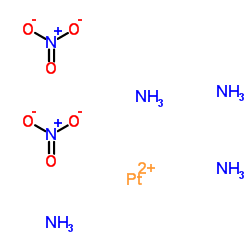Effect of two complex platinum salts on human sperm motility and acrosome reaction.
M Eberl, H C Schuppe, F M Köhn, W B Schill
Index: Andrologie 32(4-5) , 303-10, (2000)
Full Text: HTML
Abstract
Hydrogen hexachloroplatinate, H2PtCl6, has been shown to induce the human sperm acrosome reaction in vitro. However, the molecular mechanism underlying this exocytic process has not been studied. Therefore, two structurally and chemically different platinum (Pt) compounds, the potent sensitizer sodium-hexachloro-platinate-(IV), Na2[PtCl6], and the nonimmunogenic tetraamineplatinum-(II)-chloride, [Pt(NH3)4]Cl2, were selected for the experiments. Their effects on human sperm function and second messenger pathways were investigated. Washed human spermatozoa were treated with different concentrations of both Pt salts (0.5-1000 microM) during or after capacitation for 3 h at 37 degrees C. In addition, spermatozoa were incubated with Pt salts in calcium-free medium or in the presence of the protein kinase A+C inhibitor H7. Sperm motility was evaluated by computer-assisted sperm analysis; acrosomal loss was detected by triple staining. Compared with the controls (6.6+/-2.4%), the percentages of living acrosome-reacted spermatozoa showed a significant dose-dependent increase (P<0.001) after 3 h of incubation with Na2[PtCl6] (7.9+/-4.2% for 0.5 microM 25.0+/-2.9% for 1 mM) and [Pt(NH3)4]Cl2 (7.9+/-3.9% to 21.0+/-5.8%). Sperm motility was markedly reduced in samples containing the highest concentrations of the Pt salts. The acrosome reaction was also significantly increased when spermatozoa had first been capacitated and then treated with both Pt salts. Calcium-free medium had no effect on the ability of both Pt salts to induce the acrosome reaction. However, incubation of Na2[PtCl6] in the presence of H7 tendentiously decreased the percentage of acrosome-reacted spermatozoa. In conclusion, complex Pt salts such as Na2[PtCl6] or [Pt(NH3)4]Cl2 influence human sperm functions by inducing the acrosome reaction during or after capacitation. This stimulatory effect is independent of calcium and seems to be dependent on protein kinase A or C.
Related Compounds
| Structure | Name/CAS No. | Molecular Formula | Articles |
|---|---|---|---|
 |
Platinum(2+) nitrate ammoniate (1:2:4)
CAS:20634-12-2 |
H12N6O6Pt |
|
Block by ruthenium red of the ryanodine-activated calcium re...
1993-12-01 [J. Gen. Physiol. 102(6) , 1031-56, (1993)] |
|
Symmetry properties of tetraammine platinum(II) with C2v and...
2005-03-01 [J. Zhejiang Univ. Sci. B 6(3) , 222-6, (2005)] |
|
Irradiation enhances cellular uptake of carboplatin.
1995-10-15 [Int. J. Radiat. Oncol. Biol. Phys. 33(3) , 641-6, (1995)] |
|
Irradiation-enhanced binding of carboplatin to DNA.
1995-12-01 [Int. J. Radiat. Biol. 68(6) , 609-14, (1995)] |
|
Conformational landscape of platinum(II)-tetraamine complexe...
2010-03-01 [J. Comput. Aided Mol. Des. 24(3) , 225-35, (2010)] |